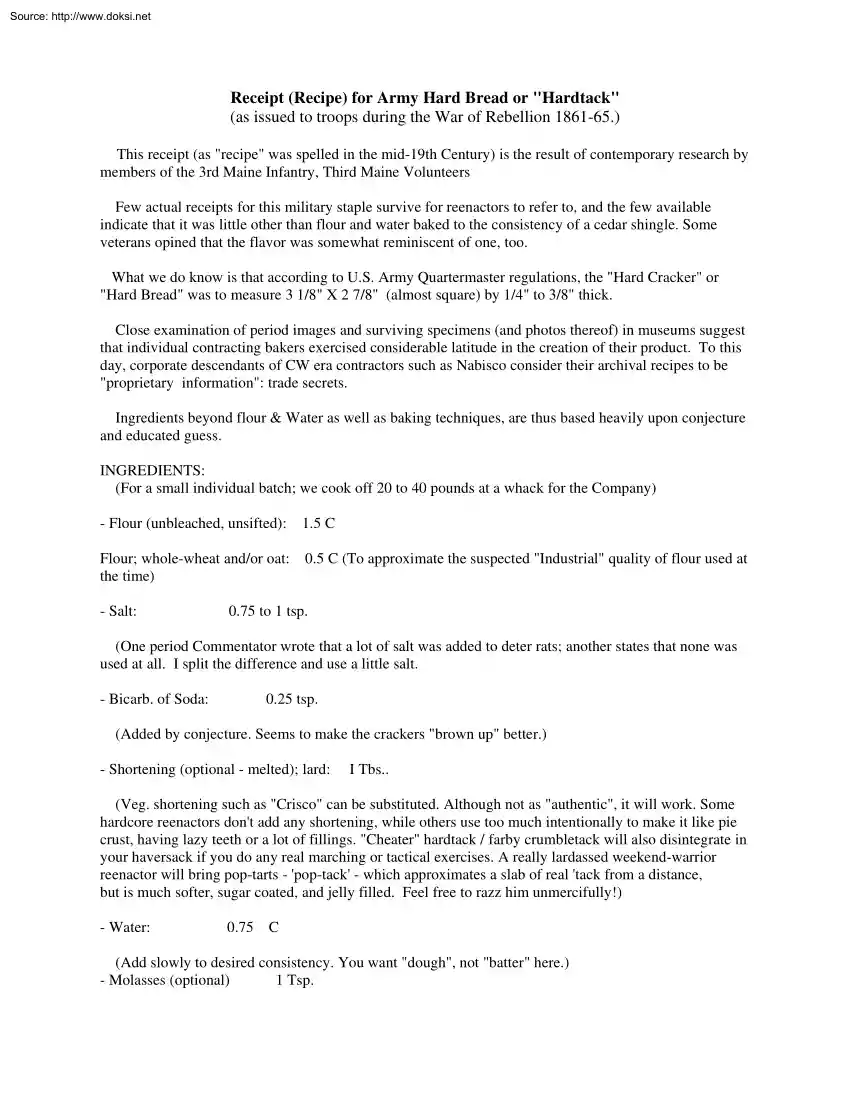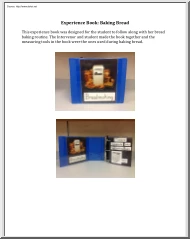A doksi online olvasásához kérlek jelentkezz be!

A doksi online olvasásához kérlek jelentkezz be!
Nincs még értékelés. Legyél Te az első!
Tartalmi kivonat
Source: http://www.doksinet Receipt (Recipe) for Army Hard Bread or "Hardtack" (as issued to troops during the War of Rebellion 1861-65.) This receipt (as "recipe" was spelled in the mid-19th Century) is the result of contemporary research by members of the 3rd Maine Infantry, Third Maine Volunteers Few actual receipts for this military staple survive for reenactors to refer to, and the few available indicate that it was little other than flour and water baked to the consistency of a cedar shingle. Some veterans opined that the flavor was somewhat reminiscent of one, too. What we do know is that according to U.S Army Quartermaster regulations, the "Hard Cracker" or "Hard Bread" was to measure 3 1/8" X 2 7/8" (almost square) by 1/4" to 3/8" thick. Close examination of period images and surviving specimens (and photos thereof) in museums suggest that individual contracting bakers exercised considerable latitude in the creation
of their product. To this day, corporate descendants of CW era contractors such as Nabisco consider their archival recipes to be "proprietary information": trade secrets. Ingredients beyond flour & Water as well as baking techniques, are thus based heavily upon conjecture and educated guess. INGREDIENTS: (For a small individual batch; we cook off 20 to 40 pounds at a whack for the Company) - Flour (unbleached, unsifted): 1.5 C Flour; whole-wheat and/or oat: the time) 0.5 C (To approximate the suspected "Industrial" quality of flour used at - Salt: 0.75 to 1 tsp (One period Commentator wrote that a lot of salt was added to deter rats; another states that none was used at all. I split the difference and use a little salt - Bicarb. of Soda: 0.25 tsp (Added by conjecture. Seems to make the crackers "brown up" better) - Shortening (optional - melted); lard: I Tbs. (Veg. shortening such as "Crisco" can be substituted Although not as
"authentic", it will work Some hardcore reenactors don't add any shortening, while others use too much intentionally to make it like pie crust, having lazy teeth or a lot of fillings. "Cheater" hardtack / farby crumbletack will also disintegrate in your haversack if you do any real marching or tactical exercises. A really lardassed weekend-warrior reenactor will bring pop-tarts - 'pop-tack' - which approximates a slab of real 'tack from a distance, but is much softer, sugar coated, and jelly filled. Feel free to razz him unmercifully!) - Water: 0.75 C (Add slowly to desired consistency. You want "dough", not "batter" here) - Molasses (optional) 1 Tsp. Source: http://www.doksinet Although no evidence supports original use, I like it. I made a batch with half oat flour and a good dose of "sor'ghum" once and although perhaps "farby", it was delicious and had a little more protein without the bugs
MIXING AND BAKING: Thoroughly mix dry ingredients; add melted shortening and molasses (if desired). Slowly add water, kneading into a tough, firm, elastic ball on a floured surface until flour will no longer stick to it. Knock it onto or against a hard surface for a bit, turning it between whacks as a potter might do to a gob of clay to drive out any air bubbles. Lay a clean linen, canvas or cotton duck cloth at least 18"H X 24L" down on a strong, flat, steady table or counter and dust some flour over it. Schmoosh the dough ball into a "brick" and lay it in the middle of the cloth. Press down to flatten and turn over a couple of times Then with an old-fashioned wooden roller, roll it out to a sort of rectangular shape, about 3/16" thick. Keep the cloth and roller floured up sufficiently so the dough does not stick to them as you roll in out. Try to maintain a consistent thickness over the sheet of dough. Score the slab with a long ruler or similar device into
aprox. 3 inch squares They can be a little rectangular; 2 3/4" or so on the short side. Poke vent holes deeply into the dough in a pattern, like saltines. Many of the crackers had an even 4X4 array, but different contractors seem to have used different hole patterns. A block of wood can be fitted with a set of wooden "fingers", dulled nails etc. to "stamp" the hole arrays Don't use a sharp poker; you want to displace some of the dough around the hole. Chopsticks work pretty well The holes let the steam out as the crackers bake. If you don't pierce the sheet well enough, you will get crispy popovers instead of hardtack! Trim off the uneven edges around the scored crackers and transfer the sheet to the baking pan. You can (and I often do) lift or slide the whole cloth and all into the pan and bake the slabs right on the cloth. It keeps the dough from distorting as it is handled and baked. If you'd rather, you can separate the crackers and transfer
them with a spatula, leaving just a little space between them. Bake in a 400 degree oven (Pizza ovens work wonderfully) for about 20 minutes, or until browned. Turn over and DRY in open 150º oven (or suitable area over oven etc.) for about an hour The crackers should thicken up to about 3/8" (Army Specs) but not much more. Now here's the "secret" of hardtack; It was "Kiln Dried" much like green lumber is for hours in a brick kiln. We reproduce this general effect by racking crackers up in the oven loosely so that the hot air can circulate around them. Set it at about 175 degrees and leave the door cracked a bit You can turn 'em over a time or two during the drying phase, but probably don't really need to. Give them at least an hour; 2 or 3 is better. After the crackers cool enough to handle, pack the keepers as well as you can to keep them dry. (Waxed paper works fairly well and is a period-correct material. This drying is what keeps the
'tack palatable - as long as it is kept dry - for months or even years. Hardtack is essentially the same as the "Pilot Bread" carried aboard sailing ships to supply carbohydrates Source: http://www.doksinet to the crews for a couple of centuries prior to the CW. When President "Teddy" Roosevelt sent the "Great White Fleet" around the World to conduct "Gunboat Diplomacy" in the early 1900's, Surplus hardtack left over from the War Between the States was apparently included in their larder. It was probably about 50 years old at the time. "Pilot Crackers", available at most food markets today, (Nabisco makes 'em) is essentially a domesticated (thinner, and considerably more chewable) descendant of the stuff hardy New Englanders gnawed on while chasing whales, plying the China tea trade aboard tall clipper ships, or marching along the dusty road to Gettysburg. Hardly necessary for school demonstrations, but for those
interested in "authentic" Living History; Hard Crackers were apparently made like waffles in scored sheets of four squares each (which, about a foot square, was about the dimensions of the haversack it was to be toted in), and wrapped in bundles or "mummies" of about a dozen each in what appears in at least one surviving specimen to be common waxed paper, similar to that commonly available today. The seams were apparently ironed down to seal them. It was then packed for shipping (50 pounds or so) in hickory-bound wooden boxes measuring 26"X17"X11". Unfortunately, it was frequently stored outdoors piled along railroad sidings, etc, where it got damp and consequently delivered to hungry patriots stale, moldy, and inhabited by hosts of worms, weevils, and other assorted unsavory vermin. Civil War hardtack, properly prepared, travels a lot better than it eats. It was made to keep hardmarching and fighting men alive (from starvation, not from disease or
bullets); not necessarily happy, just alive. Few Soldiers seem to have had the fortitude or teeth to actually chew it; a small hunk might be broken off and held in the mouth like hard candy until sufficiently softened to safely masticate. In camp or during a rest break on the march, a slab of tack might be dissolved in a dipper of coffee to thicken it up a bit. Some grizzled Veterans actually developed a liking for the bugs and weevils which frequently abandoned their sinking cracker as it boiled. One Veteran wrote that he "preferred (his) game cooked" No doubt they contributed to the crucial protein in one's diet. Soaked in water or beaten into submission with a musket-butt, backside of an axe etc., the resultant mush or fragments could be mixed with salt-pork grease and fried up into a popular delicacy known as "Skilligallee". and they wondered why chronic diarrhea was such a problem!! Stacking up alternating layers of hardtack, "salt horse" and
onions in a pot and simmering over a slow fire for a few hours made another favored Army treat, "Lobscouse". When the modern Reenactor curious civilian) pits teeth against hardtack, it is not a given thing that teeth will win. Even attempted munching by youngsters with braces or other dental appliances is NOT recommended! Some of the CW soldiers actually liked the stuff; our "replica" 'tack, when enjoyed with due caution within the first year or so of manufacture, has proved to be as tasty as it is nourishing, and has been a popular commodity among the ranks of the 3rd Maine. Even after it becomes stale, it makes good theatrical props or authentic "litter" around camp. If you have a live-fire range, it can provide "reactive targets" to shoot at. Up here in Maine we have been know to break it up and and toss chunks up in the air for the seagulls to snatch in-flight. "Uncle Jaque", Fifer 3rd Reg't Maine Vol. Inf'y ~ Field
Music / Occasional Armorer Co "A"
of their product. To this day, corporate descendants of CW era contractors such as Nabisco consider their archival recipes to be "proprietary information": trade secrets. Ingredients beyond flour & Water as well as baking techniques, are thus based heavily upon conjecture and educated guess. INGREDIENTS: (For a small individual batch; we cook off 20 to 40 pounds at a whack for the Company) - Flour (unbleached, unsifted): 1.5 C Flour; whole-wheat and/or oat: the time) 0.5 C (To approximate the suspected "Industrial" quality of flour used at - Salt: 0.75 to 1 tsp (One period Commentator wrote that a lot of salt was added to deter rats; another states that none was used at all. I split the difference and use a little salt - Bicarb. of Soda: 0.25 tsp (Added by conjecture. Seems to make the crackers "brown up" better) - Shortening (optional - melted); lard: I Tbs. (Veg. shortening such as "Crisco" can be substituted Although not as
"authentic", it will work Some hardcore reenactors don't add any shortening, while others use too much intentionally to make it like pie crust, having lazy teeth or a lot of fillings. "Cheater" hardtack / farby crumbletack will also disintegrate in your haversack if you do any real marching or tactical exercises. A really lardassed weekend-warrior reenactor will bring pop-tarts - 'pop-tack' - which approximates a slab of real 'tack from a distance, but is much softer, sugar coated, and jelly filled. Feel free to razz him unmercifully!) - Water: 0.75 C (Add slowly to desired consistency. You want "dough", not "batter" here) - Molasses (optional) 1 Tsp. Source: http://www.doksinet Although no evidence supports original use, I like it. I made a batch with half oat flour and a good dose of "sor'ghum" once and although perhaps "farby", it was delicious and had a little more protein without the bugs
MIXING AND BAKING: Thoroughly mix dry ingredients; add melted shortening and molasses (if desired). Slowly add water, kneading into a tough, firm, elastic ball on a floured surface until flour will no longer stick to it. Knock it onto or against a hard surface for a bit, turning it between whacks as a potter might do to a gob of clay to drive out any air bubbles. Lay a clean linen, canvas or cotton duck cloth at least 18"H X 24L" down on a strong, flat, steady table or counter and dust some flour over it. Schmoosh the dough ball into a "brick" and lay it in the middle of the cloth. Press down to flatten and turn over a couple of times Then with an old-fashioned wooden roller, roll it out to a sort of rectangular shape, about 3/16" thick. Keep the cloth and roller floured up sufficiently so the dough does not stick to them as you roll in out. Try to maintain a consistent thickness over the sheet of dough. Score the slab with a long ruler or similar device into
aprox. 3 inch squares They can be a little rectangular; 2 3/4" or so on the short side. Poke vent holes deeply into the dough in a pattern, like saltines. Many of the crackers had an even 4X4 array, but different contractors seem to have used different hole patterns. A block of wood can be fitted with a set of wooden "fingers", dulled nails etc. to "stamp" the hole arrays Don't use a sharp poker; you want to displace some of the dough around the hole. Chopsticks work pretty well The holes let the steam out as the crackers bake. If you don't pierce the sheet well enough, you will get crispy popovers instead of hardtack! Trim off the uneven edges around the scored crackers and transfer the sheet to the baking pan. You can (and I often do) lift or slide the whole cloth and all into the pan and bake the slabs right on the cloth. It keeps the dough from distorting as it is handled and baked. If you'd rather, you can separate the crackers and transfer
them with a spatula, leaving just a little space between them. Bake in a 400 degree oven (Pizza ovens work wonderfully) for about 20 minutes, or until browned. Turn over and DRY in open 150º oven (or suitable area over oven etc.) for about an hour The crackers should thicken up to about 3/8" (Army Specs) but not much more. Now here's the "secret" of hardtack; It was "Kiln Dried" much like green lumber is for hours in a brick kiln. We reproduce this general effect by racking crackers up in the oven loosely so that the hot air can circulate around them. Set it at about 175 degrees and leave the door cracked a bit You can turn 'em over a time or two during the drying phase, but probably don't really need to. Give them at least an hour; 2 or 3 is better. After the crackers cool enough to handle, pack the keepers as well as you can to keep them dry. (Waxed paper works fairly well and is a period-correct material. This drying is what keeps the
'tack palatable - as long as it is kept dry - for months or even years. Hardtack is essentially the same as the "Pilot Bread" carried aboard sailing ships to supply carbohydrates Source: http://www.doksinet to the crews for a couple of centuries prior to the CW. When President "Teddy" Roosevelt sent the "Great White Fleet" around the World to conduct "Gunboat Diplomacy" in the early 1900's, Surplus hardtack left over from the War Between the States was apparently included in their larder. It was probably about 50 years old at the time. "Pilot Crackers", available at most food markets today, (Nabisco makes 'em) is essentially a domesticated (thinner, and considerably more chewable) descendant of the stuff hardy New Englanders gnawed on while chasing whales, plying the China tea trade aboard tall clipper ships, or marching along the dusty road to Gettysburg. Hardly necessary for school demonstrations, but for those
interested in "authentic" Living History; Hard Crackers were apparently made like waffles in scored sheets of four squares each (which, about a foot square, was about the dimensions of the haversack it was to be toted in), and wrapped in bundles or "mummies" of about a dozen each in what appears in at least one surviving specimen to be common waxed paper, similar to that commonly available today. The seams were apparently ironed down to seal them. It was then packed for shipping (50 pounds or so) in hickory-bound wooden boxes measuring 26"X17"X11". Unfortunately, it was frequently stored outdoors piled along railroad sidings, etc, where it got damp and consequently delivered to hungry patriots stale, moldy, and inhabited by hosts of worms, weevils, and other assorted unsavory vermin. Civil War hardtack, properly prepared, travels a lot better than it eats. It was made to keep hardmarching and fighting men alive (from starvation, not from disease or
bullets); not necessarily happy, just alive. Few Soldiers seem to have had the fortitude or teeth to actually chew it; a small hunk might be broken off and held in the mouth like hard candy until sufficiently softened to safely masticate. In camp or during a rest break on the march, a slab of tack might be dissolved in a dipper of coffee to thicken it up a bit. Some grizzled Veterans actually developed a liking for the bugs and weevils which frequently abandoned their sinking cracker as it boiled. One Veteran wrote that he "preferred (his) game cooked" No doubt they contributed to the crucial protein in one's diet. Soaked in water or beaten into submission with a musket-butt, backside of an axe etc., the resultant mush or fragments could be mixed with salt-pork grease and fried up into a popular delicacy known as "Skilligallee". and they wondered why chronic diarrhea was such a problem!! Stacking up alternating layers of hardtack, "salt horse" and
onions in a pot and simmering over a slow fire for a few hours made another favored Army treat, "Lobscouse". When the modern Reenactor curious civilian) pits teeth against hardtack, it is not a given thing that teeth will win. Even attempted munching by youngsters with braces or other dental appliances is NOT recommended! Some of the CW soldiers actually liked the stuff; our "replica" 'tack, when enjoyed with due caution within the first year or so of manufacture, has proved to be as tasty as it is nourishing, and has been a popular commodity among the ranks of the 3rd Maine. Even after it becomes stale, it makes good theatrical props or authentic "litter" around camp. If you have a live-fire range, it can provide "reactive targets" to shoot at. Up here in Maine we have been know to break it up and and toss chunks up in the air for the seagulls to snatch in-flight. "Uncle Jaque", Fifer 3rd Reg't Maine Vol. Inf'y ~ Field
Music / Occasional Armorer Co "A"



